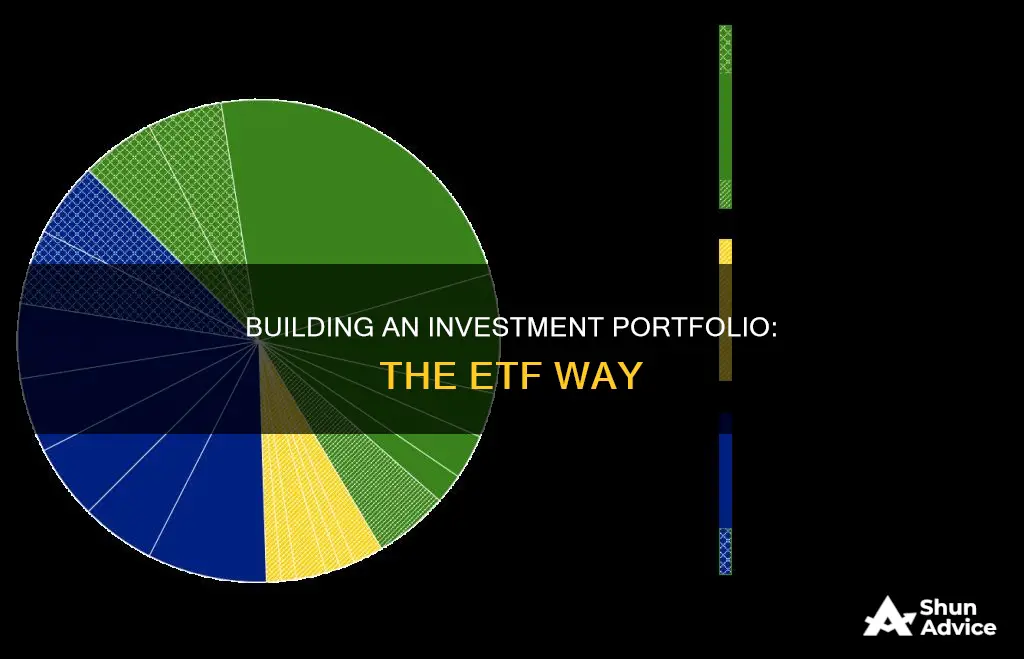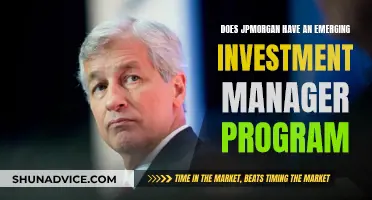
Exchange-traded funds (ETFs) are an increasingly popular investment vehicle, with thousands to choose from and total ETF assets reaching almost $10 trillion by 2022. ETFs are similar to mutual funds but are traded on an exchange like stocks, which means their prices fluctuate throughout the day. They are also very liquid and relatively inexpensive.
ETFs are baskets of securities, and most track a particular index, like the S&P 500, or are based on a sector or commodity. They offer diversification, allowing investors to gain exposure to a wide range of assets within a single investment.
Building an ETF portfolio requires careful consideration of your investment goals, risk tolerance, asset mix, and the types of ETFs you want to include. You'll also need to research and analyse different ETFs, taking into account factors such as expense ratios, assets under management, and performance history.
There are several ways to structure your ETF portfolio, from keeping it simple with just a few ETFs to a more complex approach with 20 or more ETFs. Ultimately, the right combination of ETFs can provide a balanced and diversified portfolio tailored to your financial goals and risk appetite.
| Characteristics | Values |
|---|---|
| Investment goals | Education savings, retirement |
| Risk tolerance | Higher risk tolerance = higher allocation to riskier investments |
| Asset mix | Stocks, bonds, cash |
| ETF portfolio structure | Core-and-satellite, equal-weight |
| Research and analysis | Expense ratio, assets under management, performance history |
| Entry strategy | Dollar-cost averaging, market cues, target allocations |
| Advantages | Excellent diversification, low operating expense ratio, transparency |
| Disadvantages | No potential to outperform the market, no active management |
What You'll Learn

Define investment goals
Before creating an investment portfolio, it is crucial to define your investment goals and risk tolerance. This involves asking yourself a series of questions to gain clarity and tailor your portfolio to your specific needs and circumstances.
Firstly, what is your investment goal? Are you investing for retirement, to make the most of your savings, to save for a house or your children's future, or to generate income to live off? Your investment goal will depend on your time horizon, which is the length of time you plan to hold your investments. If you have short-term goals, such as saving for a house deposit in a few years, you will likely want to invest in less risky assets. On the other hand, if you have a long-term goal like retirement, you may be more comfortable taking on riskier investments with higher potential returns.
Next, you need to assess your tolerance for risk. This can be challenging as it involves evaluating your comfort level with risk and how it aligns with your financial situation, goals, and personality. Consider the following factors:
- Experience: How long have you been investing?
- Expectations: Do you find riskier products with higher potential returns more appealing than less risky options with lower returns?
- Risk awareness: How would you distribute your assets according to different risk/return frameworks?
- Loss sensitivity: How would you react if your portfolio dropped by 30%?
Finally, evaluate your capacity for taking on risk. This is determined by your financial situation, including your income, expenses, debts, and assets. Ask yourself:
- Savings capacity: How much can you save annually after expenses?
- Time horizon: Do you need a substantial sum in the future, and if so, when?
- Loss of income: If you lose your job, how long will your savings last while maintaining your current standard of living?
Remember, your financial situation, goals, and even your attitude towards risk may change over time, so it's important to repeat this process regularly to ensure your investment strategy remains aligned with your needs.
Gross Saving and Investment: Understanding the Basics
You may want to see also

Assess risk tolerance
When creating an investment portfolio, assessing your risk tolerance is crucial. Risk tolerance refers to the degree of risk an investor is willing to take on, given the volatility in the value of an investment. It is influenced by factors such as age, investment goals, income, future earning capacity, and the presence of other assets. Understanding your risk tolerance will help you determine the type and amount of investments to include in your portfolio.
There are generally three types of risk tolerance: aggressive, moderate, and conservative. Aggressive investors have a higher risk tolerance and are willing to risk losing money to achieve potentially better results. They tend to be market-savvy and focus on capital appreciation rather than income preservation. Their investments often emphasize stocks with little to no allocation to bonds or cash.
Moderate investors, on the other hand, seek to balance opportunities and risks. They usually develop a portfolio with a mixture of stocks and bonds, such as a 50/50 or 60/40 structure.
Conservative investors have a lower risk tolerance and prefer investments with guaranteed returns. They are typically retirees or individuals approaching retirement age. Conservative investors often opt for low-volatility investments such as bank certificates of deposit (CDs), money markets, or U.S. Treasuries to preserve their capital and generate income.
To assess your risk tolerance, you can take online risk tolerance questionnaires or surveys, which are available on many investment websites. These tools will help you understand your comfort with risk and make more informed investment decisions. Additionally, reviewing historical returns for different asset classes can provide insight into the volatility of various financial instruments.
It's important to note that as retirement approaches, your risk tolerance may change. While taking on higher-risk investments may seem tempting, it's crucial to consider the time horizon for your financial goals. Short-term goals may be better suited for lower-risk cash investments, while long-term goals can benefit from the potentially higher returns of higher-risk assets.
Savings vs. Investment Institutions: Where Should Your Money Go?
You may want to see also

Determine the asset mix
When determining the asset mix for an ETF portfolio, it is important to consider your financial goals, risk tolerance, and investment horizon. Here are some key factors to help you determine the right asset mix:
Investment Objective
Consider what you want to achieve with this portfolio. For example, are you investing for retirement or saving for a specific goal such as a child's education? Understanding your objective will help guide your asset allocation decisions.
Risk Tolerance
Determine how much risk you are willing and able to take. If you have a high risk tolerance, you may allocate a larger portion of your portfolio to riskier assets such as equities. On the other hand, if you have a lower risk tolerance, you may prefer to allocate more to defensive assets like bonds and cash.
Time Horizon
The length of your investment horizon will also influence your asset mix. If you have a long-term horizon, you can afford to take on more risk and invest a larger portion of your portfolio in equities. Conversely, if you need your money in the short term, it is generally advisable to focus on less volatile assets such as short-term government bonds or cash.
Distribution Needs
Consider your income needs. If you require regular distributions from your portfolio, you will need to include fixed-income ETFs or equity ETFs that pay higher dividends.
Tax and Legal Considerations
Tax and legal situations can impact your asset allocation decisions. Consult with a financial advisor or tax professional to understand how taxes and legal considerations may affect your portfolio.
Personal Circumstances
Your personal situation, including your age, income, and financial obligations, will also play a role in determining your asset mix. For example, younger investors may have a higher allocation to riskier assets, while older investors may prefer a more conservative approach.
Overall Investment Strategy
Finally, consider how this ETF portfolio fits into your overall investment strategy. Ensure that it aligns with your long-term financial goals and risk tolerance.
It is important to remember that determining the right asset mix is a highly individualized process. While the above factors provide a general framework, you should tailor your asset allocation to your specific needs and circumstances. Seeking advice from a financial advisor can also help you make more informed decisions about your ETF portfolio's asset mix.
Saving or Investing: Where Should Your Money Go?
You may want to see also

Choose an ETF portfolio structure
The portfolio structure will include the chosen asset allocation, as well as the percentage allocation to the types of ETFs to be used in the portfolio. Two basic portfolio structures are "core-and-satellite" and "equal-weight".
Core-and-Satellite Portfolio Structure
The core-and-satellite portfolio is built around one or two core holdings, which receive the heaviest allocation percentages. The satellite holdings receive smaller allocation weights. Many investors use an S&P 500 ETF for a core holding and add ETFs from diverse categories, such as small-cap stock, foreign stock, various sectors, and fixed-income funds.
Equal-Weight Portfolio Structure
With an equal-weight portfolio structure, an investor will assign an equal percentage weight to each ETF in the portfolio. For example, if five ETFs are included in the portfolio, a weight of 20% will be assigned to each fund.
Other Considerations
When choosing an ETF portfolio structure, it is important to consider the level of diversification offered by the different ETFs. For instance, a portfolio with a large number of ETFs may provide greater diversification than one with only a few ETFs. Additionally, the level of risk associated with each ETF should be considered, as some ETFs may be riskier than others. Finally, the cost of each ETF should be considered, as some ETFs may have higher fees or transaction costs than others.
Invest Wisely to Secure Grandkids' College Education
You may want to see also

Research and analyse ETFs
Researching and analysing ETFs is a crucial step in creating an investment portfolio. Here are some key factors to consider:
Investment Focus and Diversification Strategy
Before selecting specific ETFs, determine your investment focus by deciding on the asset class, such as equities, bonds, or commodities, and their weighting in your portfolio. Consider whether you want broad diversification across an asset class or want to focus on specific industries, sectors, or countries. For example, you can invest in a World/All-world-ETF to spread your money globally or tilt towards emerging markets or individual countries.
Index Selection
Think about the index your ETF will track. A good index covers a significant portion of the market you want to follow. Broad market indices are ideal for diversification, and well-known indices like the FTSE All-World or MSCI World are usually very inexpensive. Compare the available ETFs on sites like justETF to find one that aligns with your chosen index.
ETF Selection Criteria
When selecting a specific ETF, consider both objective and subjective criteria:
Objective Criteria:
- Performance and Tracking Difference: Compare ETFs that follow the same index to assess their returns relative to the index's virtual return. While past performance doesn't guarantee future results, it can indicate how closely an ETF tracks its underlying index.
- Ongoing Charges (Total Expense Ratio/TER): ETFs with lower costs tend to be more attractive as they can lead to higher long-term returns. The TER measures the approximate annual charge for holding an ETF and is a useful indicator for cost comparison.
- Fund Size and Age: A fund size of over £100 million or $10 million tends to indicate profitability and lower the risk of liquidation. A fund age of at least one year, preferably three to five years, provides a more meaningful performance track record.
- Liquidity: Consider the bid-offer spread, underlying securities, fund size, daily trading volume, and market makers to assess how efficiently you can trade an ETF on the stock exchange. Broad market ETFs are usually highly liquid.
- Tax Status: Ensure your ETFs have reporting fund status to avoid unexpected tax complications. Also, consider the fund domicile to avoid withholding tax issues.
Subjective Criteria:
- Sustainability: If you have specific sustainability, social, or governance (ESG) standards, filter ETFs based on these criteria.
- Replication Method: ETFs can use full physical replication, sampling, or synthetic replication to track their index. Full physical replication is the most straightforward but isn't always available.
- Income Treatment: Distributing ETFs pay income directly to your account, while accumulating ETFs reinvest income to increase the ETF share value over time.
- ETF Provider: Evaluate ETF providers based on their customer treatment, accessibility of information, and clarity of important details.
- Fund Currency and Domicile: While these factors may not significantly impact ETF selection, it's essential to understand any potential currency risks and tax complications associated with them.
Tools and Resources
Utilise online tools and resources to aid your ETF research and analysis:
- ETF Screeners: Use screeners from platforms like Fidelity or justETF to filter ETFs based on various criteria, including performance, fees, and investment focus.
- ETF Research Platforms: Websites like ETF Research Center offer comprehensive research tools to analyse ETFs, including performance, fundamentals, and investment merit.
- Brokerage Trading Platforms: Many brokerage platforms offer asset screeners to help narrow down ETF choices based on cost, asset class, or index.
Stocks and Credit Scores: The Impact of Investment Portfolios
You may want to see also
Frequently asked questions
An exchange-traded fund (ETF) is an investment vehicle that holds a basket of securities, such as stocks, bonds, or other assets. ETFs are typically designed to track a particular index, sector, or commodity, and they offer investors diversification and exposure to a broad range of assets within a single investment.
ETFs offer several advantages, including diversification, low expense ratios, tax efficiency, and the ability to trade on exchanges throughout the trading day. They also provide transparency, as their holdings are usually disclosed daily.
When selecting ETFs, consider factors such as the fund's holdings, past performance, expense ratios, total assets under management (AUM), and daily trading volume. Diversification is key, so ensure the ETF provides exposure to multiple asset classes, holdings, and geographic regions.
Building an ETF portfolio involves several steps: defining your investment goals, assessing your risk tolerance, determining your asset mix, choosing an ETF portfolio structure ("core-and-satellite" or "equal-weight"), researching and analyzing ETFs, selecting specific ETFs, and choosing an entry strategy for buying ETFs.
ETFs can be categorized in various ways, including by their focus or asset class. Some common types include industry/sector ETFs, stock ETFs, bond ETFs, commodity ETFs, currency ETFs, dividend ETFs, and index ETFs. Each type offers unique benefits and suits different investment objectives.







